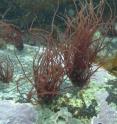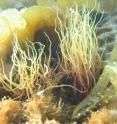Even seaweeds get sunburned
Related images
(click to enlarge)
It is red, it burns and itches: a sunburn on our skin. However, too much sun is not only bad for humans. Many plants react sensitively to an increased dose of ultraviolet radiation, too. Yet they are dependent on sunlight. With the help of pigments absorbing solar energy and light, plants produce their vitally important building blocks by means of photosynthesis. However, this has its limits: too much sun means an over-abundance of energy and thus the destruction of the sensitive pigments. The result are black spots, pale leaves and rotten parts.
Since algae cannot apply sun lotion like we do, they develop their own strategies to protect from the sun: "A species of red algae, for instance, produces under increased ultraviolet radiation less red light-harvesting proteins, thus decreasing the absorption of radiation. The typical red colour of the alga fades and the plant gets white tips.," explains Prof. Dr. Christian Wiencke, marine biologist at the Alfred Wegener Institute for Polar and Marine Research in the Helmholtz Association. "The algae additionally produce substances which react similar to melanin in human skins: mycosporin amino acids (MAA)." Melanin absorbs ultraviolet radiation and thus protects the human skin – at the same time, it gives a natural suntan.
The ozone layer usually absorbs the major part of the hard and harmful solar ultraviolet radiation of short wavelength. However, because of stratospheric ozone depletion, these dangerous rays increasingly penetrate to the earth's surface and therefore also to the seawater.
Extensive biological experiments are presently conducted on this complex of problems at the German French Research Base AWIPEV on Spitsbergen. "We examine the harmful effects of ultraviolet radiation on algae and their protective mechanisms," says Wiencke. The ultraviolet radiation particularly harms the algae's photosynthesis and their hereditary material. These organisms usually react with a decreased rate of growth or a reduction of reproductive success.
The spores and germ cells of the algae which drift through the water as unicellular organisms are particularly sensitive. Even small ultraviolet doses are damaging and inhibit their germination. "Our investigations show that the distribution of certain species of brown algae is inhibited by the climate of ultraviolet radiation. The algae are displaced into deeper water layers if ultraviolet radiation increases."
The research conditions on Spitsbergen are optimal for Wiencke and his colleagues: "We want to observe the development of marine coastal ecosystems in the face of global climate change. Not only an increased ultraviolet radiation plays a decisive role, but also the water temperature which has been increased by the greenhouse effect. This increase in temperature can particularly be felt on Spitsbergen, in the Atlantic sector of the Arctic."
Source: Helmholtz Association of German Research Centres
Other sources
- Even seaweeds get sunburnedfrom Biology News NetFri, 22 Aug 2008, 20:49:33 UTC
- Even Seaweeds Get Sunburnedfrom Science DailyFri, 22 Aug 2008, 16:21:21 UTC
- Even plants get sunburnedfrom PhysorgFri, 22 Aug 2008, 15:35:12 UTC

